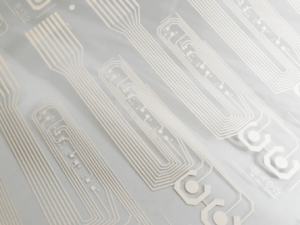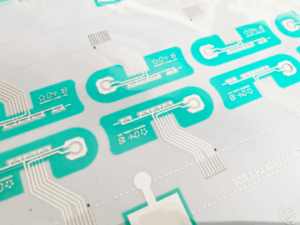The definition of printed electronics
“Printed electronics” is a broad term that encompasses any electronics created by printing onto a variety of substrates. Conductive and semiconductive inks, as well as various other materials, are printed onto these substrates. Various plastics are often used as substrates, but glass and metals can also be utilized when creating printed electronics.
A variety of printing techniques can be used in the manufacture of printed electronics, including inkjet printing, screen printing, flexography, and gravure printing. Practically speaking, almost any industrial printing technique can be utilized to create printed electronics.
Here at General Label, we offer roll-to-roll printing for printed electronics. This process allows us to manufacture large batches of printed electronics at once, lowering costs and improving time-to-market. 
How printed electronics work
The basic principle behind all printed electronics is the same: Some combination of materials, usually including conductive inks or semiconductive inks, are printed onto a substrate to create electronic parts. These inks are usually made with silver, copper, or carbon, though other materials may be used.
Once printed, the ink is dried in place—usually with heat. Additional layers may then be applied or printed; some of these layers often include insulating materials (usually plastics) to isolate and protect various components of the final part.
Thin flexible circuits are the most commonly printed electronics; printed circuit boards (PCB) are now often made using the printing techniques we’ve described. Circuits aren’t the only type of printed electronics, however. Other electronics you can print include:
- Sensors
- Batteries
- Antennae
- Photovoltaic cells
- OLEDs
- Medical
- And more
Printed electronics can be incorporated into products in much the same way non-printed electronics can be—functionally, they work the same way as non-printed electronics. One difference is the types of substrate that can be used to create printed electronics. The use of ink means that electronics can now be printed onto thin, flexible substrates, creating what are known as flexible electronics.
The benefits of printed electronics
There are a number of benefits to printing electronics over using traditional printing methods. Five of the most notable benefits are:
- Lower cost
- The ability to print onto flexible materials
- Better scalability
- More customizability
- Reduced environmental impact
The factors that make printed electronics more scalable and more affordable go hand-in-hand. Printing is an automated process, and roll-to-roll printing allows us to print electronics quickly, and in high quantities. This allows us to achieve an economy of scale—the more electronics you print, the lower the cost per unit.
Printing also allows you to create prototypes quickly and to modify your designs quickly and efficiently. This reduces the need for tooling and lowers costs.
Finally, the materials used when printing electronics are typically less expensive. This is because the parts are built up layer by layer using conductive inks and other affordable materials. These cost-savings are usually seen at scale—on smaller scales it may be more affordable to use traditional methods of building electronics.
Inks can be printed onto thin, flexible materials (usually polymers). They can be printed in patterns and shapes that would be impossible in traditional electronics manufacturing and onto incredibly small surfaces. This creates an unprecedented degree of customizability—printed electronics can be used in products of all shapes and sizes. We’ll talk more about the use cases for flexible electronics in the next section.
Finally, because fewer materials are used to create printed electronics, and there tends to be less waste in the manufacturing process, printed electronics are more environmentally friendly than more conventional electronics.

Where printed electronics are used
Printed electronics are used across a wide variety of different industries, in all kinds of electronic devices. Let’s go over a few different use cases:
Consumer electronics
Wearable devices are frequently manufactured using printed electronics—their lightweight and flexible nature makes them perfect for devices like smartwatches.
On the opposite side of the spectrum, flexible electronics have been used in consumer devices as big as TVs. LG’s flexible display OLED TV is a perfect example: It uses thin-film transistors (TFTs) and organic light-emitting diodes (OLEDs), both of which were created using printing technology.
Healthcare
Printed sensors are among the most exciting technologies in the healthcare industry. Again, wearable electronic devices are at the forefront—smartwatches and fitness trackers can be used to monitor a patient’s vital signs when they’re not in a healthcare facility. They’re also used in portable monitoring devices like continuous glucose monitors.
There are a number of other applications for printed sensors in healthcare. One example is a device called the OccluSense, developed by Bausch. This flexible sensor is thin and soft enough that a patient can bite down on it. The sensor then sends information about the bite force to their dentist, who can easily glean information about the patient’s bite.
Portable, flexible, wearable sensors are sure to become a mainstay in the industry—all thanks to printed electronics.
Transportation and logistics
The small, lightweight, and low-cost nature of printed electronics make them the perfect fit for monitoring shipments. Packages can be equipped with printed sensors to ensure that temperature, humidity, and other environmental factors remain within regulatory standards.
Printed antennae are typically used alongside these sensors for communication protocols like LoRaWAN and NFC. These printed antennae are much smaller than the antennae most people imagine—they may be only a few millimeters or less in size.
Internet of Things (IoT)
The Internet of Things (IoT) is a network made up of electronic devices using small sensors, circuits, and antennae to quickly and repeatedly transmit information. Smart light bulbs, smart thermostats, and similar technologies all make up the IoT.
These devices are a perfect use case for printed electronics. Sensors, circuits, and antennae all work in conjunction with each other so the device can transmit and receive information. These parts are usually incredibly small, and they’re often shaped unconventionally. Printing electronics is one of the best ways to manufacture IoT parts at scale.
Challenges facing printed electronics
The advantages of printed electronics are far-reaching, and we expect printed electronics to revolutionize products in almost every industry. There are, however, a few challenges facing printed electronics.
First, printed electronics tend to have poorer electrical connectivity than their traditional counterparts. We expect this problem to diminish as conductive inks and printing patterns are improved.
There are also challenges with hardware integration. Hardware is typically rigid, while printed electronics are often printed onto flexible substrates. While these substrates are perfect for flexible devices, integrating them with rigid parts can be a challenge. General Label has extensive experience in placing hardware on flexible surfaces and utilizes state of the art surface mount equipment for component placement. As industries continue to adapt to printed electronics, we expect hardware integration to be more compatible.
Some of the challenges facing the industry are common to new technologies. There’s a lack of standardization—any given printed circuit may differ substantially from another circuit designed to fulfill the same function. Different materials and printing processes may be used. There are also some legal challenges, mainly concerning intellectual property rights. Most of these challenges will resolve themselves as the industry comes to maturity.
The future of printed electronics
The future of printed electronics looks incredibly bright. We expect printed circuits and other printed electronics (like printed batteries, sensors, and antennae) to be used in a wide range of products across all industries. In the age of printed electronics, we can expect smaller, more flexible technology.
Printing electronics lowers production costs. This will make wearable technologies more cost-effective—we expect a cascading effect. More users will buy technology using printed parts, thus lowering the cost of printed electronics.
We might see anything from active clothing using printed sensors for health monitoring to small printed solar cell arrays used to charge devices become the norm. The sky’s the limit.
Conclusion
General Label is at the forefront of the printed electronics revolution. Our cost-effective printing techniques allow you to print electronics with incredibly tight tolerances at scale—and our facility is ISO 9001 certified.
Join the printed electronics revolution with General Label.